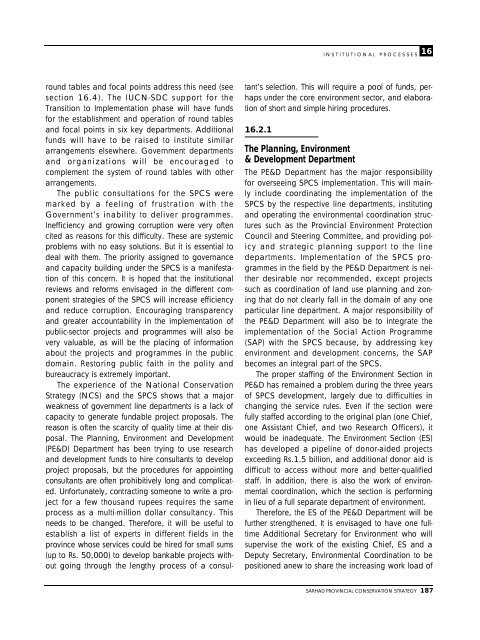Sarhad Provincial Conservation Strategy - IUCN
Sarhad Provincial Conservation Strategy - IUCN
Sarhad Provincial Conservation Strategy - IUCN
You also want an ePaper? Increase the reach of your titles
YUMPU automatically turns print PDFs into web optimized ePapers that Google loves.
ound tables and focal points address this need (see<br />
section 16.4). The <strong>IUCN</strong>-SDC support for the<br />
Transition to Implementation phase will have funds<br />
for the establishment and operation of round tables<br />
and focal points in six key departments. Additional<br />
funds will have to be raised to institute similar<br />
arrangements elsewhere. Government departments<br />
and organizations will be encouraged to<br />
complement the system of round tables with other<br />
a r r a n g e m e n t s .<br />
The public consultations for the SPCS were<br />
marked by a feeling of frustration with the<br />
Government’s inability to deliver programmes.<br />
Inefficiency and growing corruption were very often<br />
cited as reasons for this difficulty. These are systemic<br />
problems with no easy solutions. But it is essential to<br />
deal with them. The priority assigned to governance<br />
and capacity building under the SPCS is a manifestation<br />
of this concern. It is hoped that the institutional<br />
reviews and reforms envisaged in the different component<br />
strategies of the SPCS will increase efficiency<br />
and reduce corruption. Encouraging transparency<br />
and greater accountability in the implementation of<br />
public-sector projects and programmes will also be<br />
very valuable, as will be the placing of information<br />
about the projects and programmes in the public<br />
domain. Restoring public faith in the polity and<br />
bureaucracy is extremely important.<br />
The experience of the National <strong>Conservation</strong><br />
<strong>Strategy</strong> (NCS) and the SPCS shows that a major<br />
weakness of government line departments is a lack of<br />
capacity to generate fundable project proposals. The<br />
reason is often the scarcity of quality time at their disposal.<br />
The Planning, Environment and Development<br />
(PE&D) Department has been trying to use research<br />
and development funds to hire consultants to develop<br />
project proposals, but the procedures for appointing<br />
consultants are often prohibitively long and complicated.<br />
Unfortunately, contracting someone to write a project<br />
for a few thousand rupees requires the same<br />
process as a multi-million dollar consultancy. This<br />
needs to be changed. Therefore, it will be useful to<br />
establish a list of experts in different fields in the<br />
province whose services could be hired for small sums<br />
(up to Rs. 50,000) to develop bankable projects without<br />
going through the lengthy process of a consul-<br />
tant’s selection. This will require a pool of funds, perhaps<br />
under the core environment sector, and elaboration<br />
of short and simple hiring procedures.<br />
1 6 . 2 . 1<br />
The Planning, Enviro n m e n t<br />
& Development Depart m e n t<br />
I N S T I T U T I O N A L P R O C E S S E S 16<br />
The PE&D Department has the major responsibility<br />
for overseeing SPCS implementation. This will mainly<br />
include coordinating the implementation of the<br />
SPCS by the respective line departments, instituting<br />
and operating the environmental coordination structures<br />
such as the <strong>Provincial</strong> Environment Protection<br />
Council and Steering Committee, and providing policy<br />
and strategic planning support to the line<br />
departments. Implementation of the SPCS programmes<br />
in the field by the PE&D Department is neither<br />
desirable nor recommended, except projects<br />
such as coordination of land use planning and zoning<br />
that do not clearly fall in the domain of any one<br />
particular line department. A major responsibility of<br />
the PE&D Department will also be to integrate the<br />
implementation of the Social Action Programme<br />
(SAP) with the SPCS because, by addressing key<br />
environment and development concerns, the SAP<br />
becomes an integral part of the SPCS.<br />
The proper staffing of the Environment Section in<br />
PE&D has remained a problem during the three years<br />
of SPCS development, largely due to difficulties in<br />
changing the service rules. Even if the section were<br />
fully staffed according to the original plan (one Chief,<br />
one Assistant Chief, and two Research Officers), it<br />
would be inadequate. The Environment Section (ES)<br />
has developed a pipeline of donor-aided projects<br />
exceeding Rs.1.5 billion, and additional donor aid is<br />
difficult to access without more and better-qualified<br />
staff. In addition, there is also the work of environmental<br />
coordination, which the section is performing<br />
in lieu of a full separate department of environment.<br />
Therefore, the ES of the PE&D Department will be<br />
further strengthened. It is envisaged to have one fulltime<br />
Additional Secretary for Environment who will<br />
supervise the work of the existing Chief, ES and a<br />
Deputy Secretary, Environmental Coordination to be<br />
positioned anew to share the increasing work load of<br />
SARHAD PROVINCIAL CONSERVATION STRATEGY 187

















